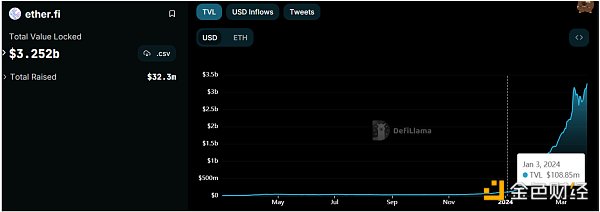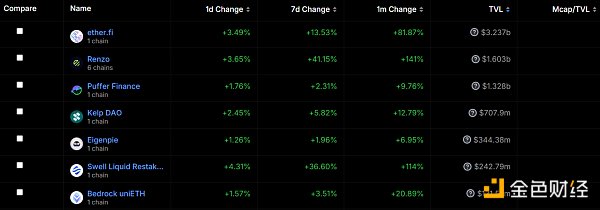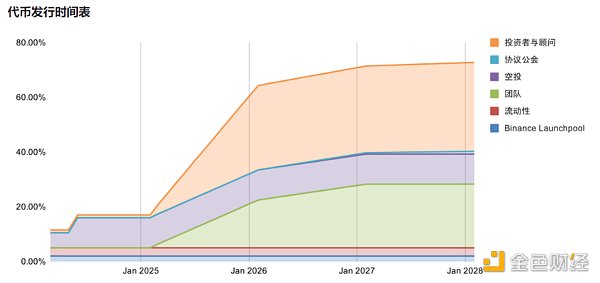Author: Climber, Golden Finance
On March 18, the Ethereum re-pledge protocol ether.fi was launched on major exchanges. After opening high, it fell back to around $3, and then continued to rise, reaching a maximum of $8.66 in less than two weeks. It is rare for a new project to see such a short-term increase. In addition, the re-staking track is gaining momentum. As the leader, ether.fi is naturally worthy of attention.
This article will comprehensively explain this leading project on the track, ether.fi, to help readers understand the project and find out its value.
Strong performance
Judging from the currency price trend, ether.fi has performed well since its launch. As of this writing, the price of ETHFI is as low as US$2.83 and as high as US$8.66, with an increase of 208% during the period. For newly listed currencies on the exchange, a twofold increase in a short period of time is quite objective.

p>
Judging from the data performance on the project chain, according to DefiLama data, the current TVL of ether.fi is US$3.252 billion. As can be seen from the picture above, Ether.fi TVL has entered a high-growth mode since about January this year. In just three months, it has increased from nearly US$100 million to over US$3 billion, an increase of up to 30 times.

p>
Comparing other competitors in the same track, it can be clearly seen that ether.fi is far ahead of other similar competitors, and its TVL is about twice that of the second place Renzo. . From the perspective of TVL growth, the monthly growth rates of ether.fi, Renzo, and swell network are all around 100%, especially Renzo.
Regarding the generally high growth of TVL on the re-staking track, a senior industry analyst said that this is mainly due to the demand for projects that can provide consensus-safe AVS services. There is huge expected demand. At the same time, the re-pledge track is also favored by many institutions and investors.
Golden Finance once pledged again in " in early February this year The article "Comparison of the development status of representative projects in the article "Comparison of the Development Status of Representative Projects" in which the track continues to heat up provides a detailed comparison of the development status of several leading projects, and points out the possibility of an outbreak of the staking track due to the impact of the Ethereum Cancun upgrade. Readers can move here Check.
Introduction to ether.fi
ether.fi is a A non-custodial staking protocol built on Ethereum, founded by Mike Silagadze and launched in 2023.
Unlike other liquidity staking protocols, ether.fi allows participants to retain control of their keys while staking their tokens and can exit at any time validators to reclaim their ETH.
This is mainly reflected in two aspects:
Pledgers generate and hold their own pledges ETH key.
NFTs are minted for every validator launched through ether.fi.
For most other delegated staking protocols, the starting point is that the staker deposits their ETH and is matched with a node operator, Node Operator
strong>Generate and hold pledge certificates. Although this approach can make the protocol unmanaged, in most cases it actually creates a managed or semi-managed mechanism. This could expose stakers to significant and opaque counterparty risk.
With ether.fi, stakers can control their keys and retain custody of their ETH, while entrusting the pledge to the node operator, which greatly reduce their exposure to risks.
Technically speaking, in Ethereum's PoS pledge, two keys will be generated: the withdrawal key and the verification key. The withdrawal key is used to withdraw the user's assets, while the verification key means that the node operator needs to use this key to verify the block within the specified time to obtain verification rewards.
ether.fi uses key management technology to realize the separate management of withdrawal keys and verification keys in pledge delegation, further optimizing the security of ETH pledge services. . It also creates a node service market where stakers and node operators can register nodes to provide infrastructure services, and the revenue from these services is shared with stakeholders and node operators.
Users can deposit funds into ether.fi and receive returns on their investment in the form of staking rewards (supply-side fees), in the process ether.fi also It can automatically pledge users' deposits to Eigenlayer to obtain income. Eigenlayer uses the pledged ETH to support external systems (such as rollups and oracles). It improves the income of ETH pledgers by establishing an economic security layer.
The sum of all staking rewards is divided between stakers, node operators and protocols at 90%, 5% and 5% respectively. Users can generally receive: Ethereum staking rewards; ether.fi loyalty points; re-staking rewards (including EigenLayer points); rewards for providing liquidity to the Defi protocol.
Financing information:
ether.fi in 2023 On February 2, 2019, it completed US$5.3 million in financing, led by North Island Ventures, Chapter One and Node Capital, with participation from BitMex founder Arthur Hayes.
In addition, ether.fi also completed US$23 million in financing in February this year, with financing from more than 95 investment institutions including Amber Group, BanklessVC, OKX Ventures, etc. Support from individual investors.
At present, ether.fi has announced the information of 5 team members in the official Docs. Among them, founder Mike Silagadze: is currently the CEO of DeFi fund company Gadze Finance and also Founder of Canadian higher education platform Top Hat (US$130 million in Series E financing in 2021).
Token Economics:

ether.fi token economic model shows that ether.fi token The total supply of ETHFI is 1 billion, and the initial circulating supply is 115.2 million. 2% of the token allocation will be used for Binance Launchpool, 11% will be allocated to airdrops, 32.5% will be allocated to airdrop investors and advisors, and 23.26% will be allocated to Binance Launchpool. To the team, 1% is allocated to the Protocol Guild, 27.24% is allocated to the DAO Treasury, and 3% is used to provide liquidity.

p>
However, in terms of unlocking time, ETHFI will not be significantly released until next year, and it will not reach more than 60% until 2026, which reflects the market size of ETHFI from the side. Chips have a certain scarcity.
However, judging from the airdrop information of ether.fi on March 18, the top 20 addresses in the reward list contributed one-third to ether.fi One TVL (273,000 ETH) and received an ETHFI airdrop of 9.96 million.
The person who received the largest number of airdrops was Justin Sun, who deposited 120,000 ETH ($435 million) into ether.fi on the 13th and received 345 Ten thousand ETHFI airdrops. Judging from the pledge airdrop ratio, it is about 1:3, which means that users can get 3 ETHFI by pledging 1 ETF, which is only US$26 based on the highest price of ETHFI.
Project Progress and Roadmap
In March this year, ether.fi has launched the second quarter of the points activity StakeRank, which will be held from March 15 to June 30. The rewards will account for 5% of the total supply of ETHFI. Not long ago, ether.fi conducted an airdrop of 68 million ETHFI (6.8% of the total amount). At the same time, the project also launched the Restaking Paradigm product with Manta Network.
In February, DeFi yield market Pendle announced its cooperation with the Ethereum pledge agreement ether.fi to launch the first LRT asset eETH on Arbitrum. In January, ether.fi announced the establishment of an advisory board, with members including independent Ethereum educator sassal.eth, Polygon founder Sandeep Nailwal, Arrington Capital founder Michael Arrington, Ethereum Foundation member SnapCrackle.eth, etc.
In November last year, the ether.fi mainnet was launched and the liquid staking token eeth was released. In October, ether.fi launched the liquid pledge token (LST) eETH and also announced its decentralization roadmap. In May, ether.Fi launched the first phase of its mainnet.
According to its official website roadmap:
In August last year, ether.fi and Obol Labs jointly launched the first DVT mainnet validator, which was then incorporated into mainnet’s first wave of validators, which are run by a geographically dispersed group of small independent operators.
In October last year, ether.fi open sourced its smart contract suite. In November, eETH, ether.fi’s Liquid Stake token, was launched. Users will be able to participate in Ethereum staking in a completely permissionless manner and buy and sell pledged assets on demand.
In April this year, ether.fi is expected to complete the second phase of DVT integration. In DVT Phase 1, ether.fi has partnered with Obol Labs to offer mainnet DVT – verifications shared by different individuals, none of whom has the full validator key. Phase two will move to fully automated integration, where users will arrive, apply and start as individual stakers, unmanaged and unassisted by ether.fi and Obol.
At the same time, ether.fi will also implement DAO governance and TGE.
In addition, ether.fi mainnet v3 is planned to be released in early second quarter and will include some special features, such as the ability for users to run personal nodes with 2 ETH Bond.
Summary
Since last year, around the re-staking competition There are more and more discussions and studies on Tao. At the beginning of this year, the re-staking track has gained momentum, and ether.fi, as the leader of the track, was the first to be listed on the exchange and performed well, which inevitably makes investors more optimistic about the track.
For users who prefer staking to earn money, security and profitability are the biggest considerations. ether.fi's DVT technology can greatly ensure the security of users' pledged assets, and can also provide users with relatively good returns. Therefore, the current products and services of ether.fi do have certain prospects, but the aspects of smart contracts and technical security still need time to be tested.
 Wilfred
Wilfred








